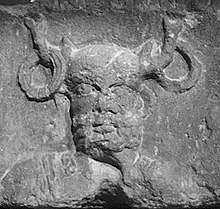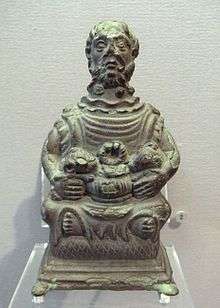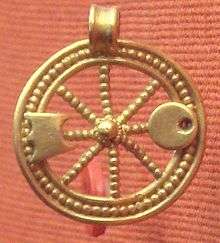Cernunnos
Cernunnos is the conventional name given in Celtic studies to depictions of the "horned god" of Celtic polytheism. Over 50 examples of his imagery have been found from the Gallo-Roman period, mostly in north-eastern Gaul as well as among the Celtiberians. Cernunnos is depicted with antlers, seated cross-legged, and is associated with stags, horned serpents, dogs, bulls, and rats. He is usually holding or wearing a torc.[1]
.jpg)
Due to the lack of surviving literature, details about his name, his followers, or his significance in Celtic religion are unknown. Interpretations of his role vary from seeing him as a god of animals, nature and fertility to a god of travel, commerce and bi-directionality.[2]
Name and etymology

The name [C]ernunnos only appears on the Pillar of the Boatmen (Pilier des nautes), a Gallo-Roman monument dating to the early 1st century CE.[3] The Proto-Celtic form of the theonym is reconstructed as either *Cerno-on-os or *Carno-on-os. The augmentative -on- is characteristic of theonyms, as in Maponos, Epona, Matronae, and Sirona.[4] Maier (2010) states that the etymology of Cernunnos is unclear, but seems to be rooted in the Celtic word for "horn" or "antler" (as in Carnonos).[5]
The Gaulish word karnon "horn" is cognate with Latin cornu and Germanic *hurnaz, English horn, ultimately from Proto-Indo-European *k̑r̥no-.[6] The etymon karn- "horn" appears in both Gaulish and Galatian branches of Continental Celtic. Hesychius of Alexandria glosses the Galatian word karnon (κάρνον) as "Gallic trumpet", that is, the Celtic military horn listed as the carnyx (κάρνυξ) by Eustathius of Thessalonica, who notes the instrument's animal-shaped bell.[7] The root also appears in the names of Celtic polities, most prominent among them the Carnutes, meaning something like "the Horned Ones,"[8] and in several personal names found in inscriptions.[9]
The name has also been compared to a divine epithet Carnonos in a Celtic inscription written in Greek characters at Montagnac, Hérault (as καρνονου, karnonou, in the dative case).[10] A Gallo-Latin adjective carnuātus, "horned," is also found.[11]
Epigraphic evidence
The Pillar of the Boatmen (Pilier des nautes) monument was probably constructed by Gaulish sailors in 14 CE.[12] It was discovered in 1710 within the foundations of the cathedral of Notre-Dame de Paris, site of ancient Lutetia, the civitas capital of the Celtic Parisii. It is now displayed in the Musée National du Moyen Age in Paris.[13]
The distinctive stone pillar is an important monument of Gallo-Roman religion. Its low reliefs depict and label by name several Roman deities such as Jupiter, Vulcan, and Castor and Pollux, along with Gallic deities such as Esus, Smertrios, and Tarvos Trigaranus. The name Cernunnos can be read clearly on 18th century drawings of the inscriptions, but the initial letter has been obscured since, so that today only a reading [_]ernunnos can be verified.[14]
Additional evidence is given by one inscription on a metal plaque from Steinsel-Rëlent in Luxembourg, in the territory of the Celtic Treveri. This inscription[15] read Deo Ceruninco, "to the God Cerunincos", assumed to be the same deity. The Gaulish inscription from Montagnac[16] reads αλλετ[ει]νος καρνονου αλ[ι]σο[ντ]εας (Alletinos [dedicated this] to Carnonos of Alisontea), with the last word possibly a place name based on Alisia, "service-tree" or "rock" (compare Alesia, Gaulish Alisiia).[17]
Iconography

The god labelled [C]ernunnos on the Pillar of the Boatmen is depicted with stag's antlers, both having torcs hanging from them. The lower part of the relief is lost, but the dimensions suggest that the god was sitting cross-legged, providing a direct parallel to the antlered figure on the Gundestrup cauldron.[19]
In spite of the name Cernunnos being attested nowhere else, it is commonly used in Celtological literature as describing all comparable depictions of horned/antlered deities.[20]
This "Cernunnos" type in Celtic iconography is often portrayed with a stag and the ram-horned serpent. Less frequently, there are bulls (at Rheims), dogs and rats.[21] Because of the image of him on the Gundestrup Cauldron, some scholars describe Cernunnos as the "Lord of the Animals" or the "Lord of Wild Things", and Miranda Green describes him as a "peaceful god of nature and fruitfulness"[22] who seems to be seated in a manner that suggests traditional shamans who were often depicted surrounded by animals.[23] Other academics such as Ceisiwr Serith describes Cernunnos as a god of bi-directionality and mediator between opposites, seeing the animal symbolism in the artwork reflecting this idea.[24]
The Pilier des nautes links him with sailors and with commerce, suggesting that he was also associated with material wealth as does the coin pouch from the Cernunnos of Rheims (Marne, Champagne, France)—in antiquity, Durocortorum, the civitas capital of the Remi tribe—and the stag vomiting coins from Niedercorn-Turbelslach (Luxembourg) in the lands of the Treveri. The god may have symbolized the fecundity of the stag-inhabited forest.
Other examples of "Cernunnos" images include a petroglyph in Val Camonica in Cisalpine Gaul. The antlered human figure has been dated as early as the 7th century BCE or as late as the 4th.[25] An antlered child appears on a relief from Vendeuvres, flanked by serpents and holding a purse and a torc.[26] The best known image appears on the Gundestrup cauldron found on Jutland, dating to the 1st century BCE, thought to depict Celtic subject matter though usually regarded as of Thracian workmanship.
Among the Celtiberians, horned or antlered figures of the Cernunnos type include a "Janus-like" god from Candelario (Salamanca) with two faces and two small horns; a horned god from the hills of Ríotinto (Huelva); and a possible representation of the deity Vestius Aloniecus near his altars in Lourizán (Pontevedra). The horns are taken to represent "aggressive power, genetic vigor and fecundity."[27]
Divine representations of the Cernunnos type are exceptions to the often-expressed view that the Celts only began to picture their gods in human form after the Roman conquest of Gaul.[28] The Celtic "horned god", while well attested in iconography, cannot be identified in description of Celtic religion in Roman ethnography and does not appear to have been given any interpretatio romana, perhaps due to being too distinctive to be translatable into the Roman pantheon.[29] While Cernunnos was never assimilated, scholars have sometimes compared him functionally to Greek and Roman divine figures such as Mercury,[30] Actaeon, specialized forms of Jupiter, and Dis Pater, the latter of whom Julius Caesar said was considered the ancestor of the Gauls.[31]
Possible reflexes in Insular Celtic
There have been attempts to find the cern root in the name of Conall Cernach, the foster brother of the Irish hero Cuchulainn[32] in the Ulster Cycle. In this line of interpretation, Cernach is taken as an epithet with a wide semantic field—"angular; victorious; bearing a prominent growth"—and Conall is seen as "the same figure" as the ancient Cernunnos.[33]
There is even greater evidence available to connect Conall Cernach to Cernunnos than the similarity in the names. A brief passage involving Conall in an eighth-century story entitled Táin Bó Fraích ("The Cattle Raid on Fraech") has been questioned before for its anti-climactic conclusion to an epic Celtic tale.[34] In this passage Conall Cernach is portrayed as a hero and mighty warrior who assists the protagonist Fraech in rescuing his wife and son, and in reclaiming for Fraech his cattle. The fort that Conall must penetrate is guarded by a mighty serpent. The supposed anti-climax of this tale is when the fearsome serpent, instead of attacking Conall, darts to Conall's waist and girdles him as a belt. Rather than killing the serpent, Conall allows it to live, and then proceeds to attack and rob the fort of its great treasures the serpent previously protected.
Cernunnos, as the conjectured Gaulish manifestation of the Roman Dis Pater,[34] is considered to share the latter's attributes of ruling over the hidden treasures of the underworld. Subterranean treasures were commonly linked in Medieval Bestiaries to the serpent,[35] the occupant of the underground, or otherworld, and the keeper of its treasures and mysteries. This aspect of Cernunnos is depicted on a stone statue from a well in Sommerécourt, Haute-Marne, France, and on a bronze figurine from Autun.[34] Both statue and figurine portray Cernunnos with the two ram-headed serpents encircling his waist. This is more than just a small similarity to the instance of the serpent that guarded the treasure of the fort in Táin Bó Fraích surrendering to Conall Cernach and becoming his belt. Cernunnos' connections to the deity Mars[34] serve to underline Conall's role as hero-warrior in the tale.
The anti-climactic nature of the eighth-century Irish tale then gains significant clarity in the light of the relationship between a horned or antler-bearing deity, warrior, or progenitor, and the chthonic dwelling, treasure-guarding serpent that encircled the waist of the one it chose to protect. This universal Celtic concept comes down to us as a mere echo of its ancient self through centuries of the Christianization of Ireland. The Gaelic Cernunnos may now possibly only be found in the slight similarity of a name and the peculiarity of a single passage from a Middle Ages Irish epic.
Possible connection to Saint Ciarán
Some see the qualities of Cernunnos subsumed into the life of Saint Ciarán of Saighir, one of the Twelve Apostles of Ireland. When he was building his first tiny cell, as his hagiograph goes, his first disciple and monk was a boar that had been rendered gentle by God. This was followed by a fox, a badger, a wolf and a stag.[36]
Neopaganism and Wicca
In Wicca and other forms of Neopaganism a Horned God is revered; this divinity syncretises a number of horned or antlered gods from various cultures, including Cernunnos. The Horned God reflects the seasons of the year in an annual cycle of life, death and rebirth.[37]
In the tradition of Gardnerian Wicca, the Horned God is sometimes specifically referred to as Cernunnos, or sometimes also as Kernunno.[38]
References in modern culture
- The French-Belgian TV thriller Zone Blanche features Cernunnos, who protects the forest from humans, hoards treasure, and revives dead characters to life.
- The German/Austrian TV thriller with supernatural streaks Der Pass features Cernunnos.
- The psychedelic downtempo group Dub Trees (fronted by Youth [Martin Glover]) produced an album in 2016 entitled The Cerronnos Dub Rituals EP[39] wherein Celtic Galician and Summerian pipes are used.
- The Argentinian folk metal band Cernunnos was named as tribute of this god and one of the songs of its first album Leaves of Blood is also named "Cernunnos".
- The comic series Sláine features an incarnation of the Horned God Carnun (based on the Gaulish deity Cernunnos).
- Cernunnos is also featured in the third-person MOBA, SMITE, classified as a Hunter.
- The band Heilung's 2019 album "Futha" displays art representing Cernunnos in several places, including a female version of the Gundestrup Cauldron Cernunnos on the art for the song "Norupo", called Cernunina, as "Futha" represents a feminine counterpart to the band's 2015 album "Ofnir"[40].
See also
- Celtic polytheism
- Celtic Reconstructionist Paganism
- Green Man
- Herne the Hunter
- Horned God
References
- Corpus Inscriptionum Latinarum (CIL) volume 13, number 03026
- Delmarre, Xavier (2003). Dictionnaire de la langue gauloise (2nd ed.). Paris: Editions Errance. ISBN 2-87772-237-6.
- Lejeune, Michel (1995). Recueil des inscriptions gauloises (RIG) volume 1, Textes gallo-grecs. Paris: Editions du CNRS.
- Nussbaum, Alan J. (1986). Head and Horn in Indo-European. Berlin, New York: Walter de Gruyter. ISBN 3-11-010449-0.
- Porkorny, Julius (1959). Indogermanisches etymologisches Wörterbuch. Berlin: Franke Verlag.
Notes
- Green, Miranda, Celtic Art, Reading the Messages, p. 147, 1996, The Everyman Art Library, ISBN 0-297-83365-0
- Green, Miranda (1992). Animals in Celtic Life and Myth. Routledge. pp. 227–8. https://ceisiwrserith.com/therest/Cernunnos/cernunnospaper.htm
- Koch, Celtic Culture, p. 396 online.
- Delamarre, citing M. Lejeune, Lepontica (Paris 1971), p. 325.
- Bernard Maier, Dictionary of Celtic Religion and Culture (Alfred Kröner, 1994; Boydell, 2000), p. 69 online.
- Pokorny (1959) "k̑er-, k̑erə-; k̑rā-, k̑erei-, k̑ereu"
- Delamarre; Greek text and English translation of the passage from Eustathius' Homeric commentaries given by Edward Wigan, "Account of a Collection of Roman Gold Coins," Numismatic Chronicle 5 (1865), p. 11 online.
- Also Carni and Carnonacae.
- Such as Carnarus, Carnatus, Carneolus, Carnius and Carnicus; Altay Coşkun with Jürgen Zeidler, "'Cover Names' and Nomenclature in Late Roman Gaul: The Evidence of the Bordelaise Poet Ausonius" (2003), p. 33.
- Xavier Delamarre, Dictionnaire de la langue gauloise (Éditions Errance, 2003), pp. 106–107.
- Equivalent to Latin cornutus, "horned"; Delamarre, citing J. Vendryes, Revue Celtique 42 (1925) 221–222.
- Based on the inscription (CIL XIII. 03026), on the accession of the emperor Tiberius.
- A. Kingsley Porter, "A Sculpture at Tandragee," Burlington Magazine 65 (1934), p. 227, pointing out the relative maturation of the antlers.
- Phyllis Fray Bober, Cernunnos: Origin and Transformation of a Celtic Divinity, American Journal of Archaeology, Vol. 55, No. 1 (Jan., 1951), pp. 13-51 https://www.jstor.org/stable/501179
- AE 1987, 0772 = AE 1989, 00542.
- RIG 1, number G-224.
- Delamarre, Dictionnaire pp. 38–39. See also Pierre-Yves Lambert, La langue gauloise (Éditions Errance, 2003), pp. 53 and 58.
- Umberto Sansoni-Silvana Gavaldo, L'arte rupestre del Pià d'Ort: la vicenda di un santuario preistorico alpino, p. 156; "Ausilio Priuli, Piancogno su "Itinera"" (in Italian). Archived from the original on 6 May 2006. Retrieved 2 April 2009..
- Green, Miranda (2003-10-03). Symbol and Image in Celtic Religious Art. Routledge. ISBN 9781134893942.
- Koch, John T. (2006). Celtic culture: a historical encyclopedia. Vol. 1-. ABC-CLIO. ISBN 9781851094400.
- Green, Miranda (2011-09-30). Gods of the Celts. The History Press. ISBN 9780752468112.
- Green, Miranda (1992) Animals in Celtic Life and Myth, p. 228.
- Aldhouse-Green, Miranda J. (2010). Caesar's Druids: story of an ancient priesthood. New Haven: Yale University Press. p. 86. ISBN 9780300165883. OCLC 808346501.
- Fickett-Wilbar, David (2003). "Cernunnos: Looking a Different Way". Proceedings of the Harvard Celtic Colloquium. 23: 80–111. ISSN 1545-0155. JSTOR 25660728.
- Webster, "Creolizing the Roman Provinces," p. 221, especially note 103.
- Anne Ross, "Chain Symbolism in Pagan Celtic Religion," Speculum 34 (1959), p. 42.
- Francisco Marco Simón, "Religion and Religious Practices of the Ancient Celts of the Iberian Peninsula," e-Keltoi: Journal of Interdisciplinary Celtic Studies 6 (2005), p. 310.
- Webster, "Creolizing the Roman Provinces," p. 221.
- Jane Webster, "Creolizing the Roman Provinces," American Journal of Archaeology 105 (2001), p. 222; distinctiveness of Cernunnos also in William Van Andringa, "Religions and the Integration of Cities in the Empire in the Second Century AD: The Creation of a Common Religious Language," in A Companion to Roman Religion (Blackwell, 2007), pp. 87–88.
- David M. Robinson and Elizabeth Pierce Belgen, "Archaeological Notes and Discussions," American Journal of Archaeology 41 (1937), p. 132.
- Phyllis Fray Bober, "Cernunnos: Origin and Transformation of a Celtic Divinity," American Journal of Archaeology 55 (1951), p. 15ff.
- Porter, A Sculpture at Tandragee, p. 227.
- John Koch. (2006) Cernunnos [in] Celtic Culture: A Historical Encyclopedia, p. 396. ABC-Clio.
- Anne Ross. (1967, 1996). Pagan Celtic Britain: Studies in Iconography and Tradition. Academy Chicago Publishers.
- Charbonneau-Lassay, Louis. (1940). The Bestiary of Christ. France: Desclée, De Brouwer, & Cie.
- Mac Cana, Proinsias (1973) [1970]. Celtic Mythology. London: The Hamlyn Publishing Group Limited. pp. 47–8. ISBN 0-600-00647-6.
- Farrar, Stewart & Janet, Eight Sabbats for Witches
- The Rebirth of Witchcraft, Doreen Valiente, page 52-53
- "Dub Trees - The Cerronnos Dub Rituals EP, by Dub Trees". Liquid Sound Design. Retrieved 2019-10-31.
- "HEILUNG - CERNUNINA FUTHA - FLAG". Season of Mist Shop. Retrieved 2 June 2020.
External links
- "Is the Gundestrup Cauldron an Authentic Celtic Artifact?": A possibly ancient depiction of the Horned God
.jpg)

